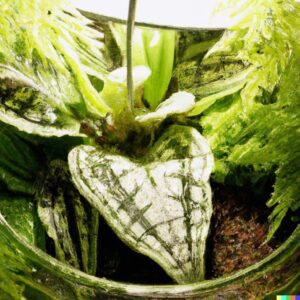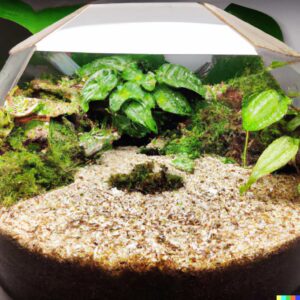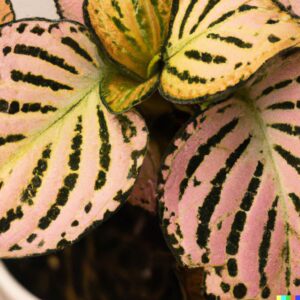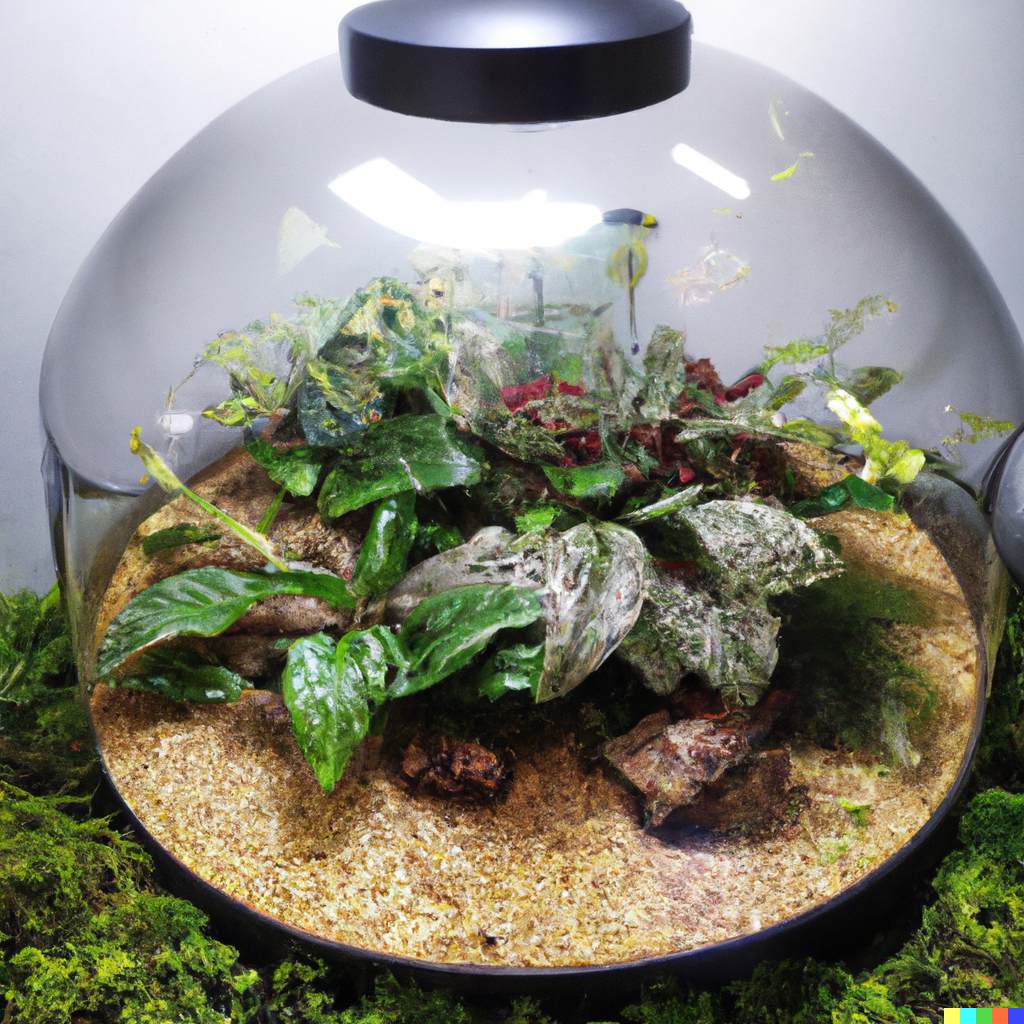Fittonia, also known as nerve plant![]() , is a popular houseplant prized for its ornate leaves with striking veined patterns. Its tropical origins mean fittonia thrives in warm, humid environments much like a closed terrarium provides, though too much humidity will also damage the plant. When cultivating fittonia in an enclosed glass container, a key decision is whether an open or closed terrarium design will better meet the plant’s needs. This comprehensive guide examines the factors to consider when growing fittonia in terrariums, so you can make an informed choice. We’ll compare airflow, humidity, watering, lighting, and other care needs in open versus closed setups. You’ll learn tips to optimize conditions for healthy fittonia growth in both types of terrariums. Follow our beginner-friendly advice and you’ll be on your way to showcasing gorgeous fittonia plants in eye-catching terrarium displays.
, is a popular houseplant prized for its ornate leaves with striking veined patterns. Its tropical origins mean fittonia thrives in warm, humid environments much like a closed terrarium provides, though too much humidity will also damage the plant. When cultivating fittonia in an enclosed glass container, a key decision is whether an open or closed terrarium design will better meet the plant’s needs. This comprehensive guide examines the factors to consider when growing fittonia in terrariums, so you can make an informed choice. We’ll compare airflow, humidity, watering, lighting, and other care needs in open versus closed setups. You’ll learn tips to optimize conditions for healthy fittonia growth in both types of terrariums. Follow our beginner-friendly advice and you’ll be on your way to showcasing gorgeous fittonia plants in eye-catching terrarium displays.
Terrariums allow gardeners to easily create a miniature greenhouse environment perfect for raising tropical plants like fittonia![]() . The enclosed space holds humidity while protecting the plants from temperature fluctuations. Fittonia’s decorative leaves with their intricate veined patterns put on a striking display behind glass. By tailoring the terrarium setup and care routines to fittonia’s preferences, both beginning and experienced gardeners can successfully grow these captivating plants in either open or closed containers. This guide provides everything you need to know to thrive with fittonia terrariums.
. The enclosed space holds humidity while protecting the plants from temperature fluctuations. Fittonia’s decorative leaves with their intricate veined patterns put on a striking display behind glass. By tailoring the terrarium setup and care routines to fittonia’s preferences, both beginning and experienced gardeners can successfully grow these captivating plants in either open or closed containers. This guide provides everything you need to know to thrive with fittonia terrariums.
Here are some key takeaways:
- Fittonia plants need high, stable humidity which can be provided by a terrarium environment.
- Closed terrariums hold in more moisture but open ones allow for better air circulation. Find the right balance for your climate.
- Monitor soil moisture closely as both overwatering and underwatering can damage fittonia. Open terrariums need more frequent watering.
- Bright, indirect light is essential. Avoid direct sun which can scorch leaves.
- Use a well-draining potting mix and pebbles or moss to optimize moisture and humidity.
- Look for terrariums with adjustable vents to control airflow as needed.
- Group multiple small fittonia plants together to increase transpiration humidity.
- Be prepared to provide attentive caretaking for fittonia in either open or closed terrariums.
Factors to Consider for Fittonia Growth in Terrariums
When deciding whether to grow your fittonia in an open or closed terrarium, there are several factors to take into account to ensure the plant thrives. As a tropical plant native to South American rainforests, fittonia requires high humidity levels, well-draining soil, filtered sunlight, and warm temperatures to grow well.
The enclosed environment of a terrarium can provide the stable humidity fittonia needs, but ventilation and airflow must also be adequate to prevent fungal diseases. Open terrariums allow for more air circulation while closed ones hold in more humidity. You’ll have to find the right balance for your climate and growing conditions.
Soil moisture is another key consideration. Fittonia prefers constantly moist soil but is prone to root rot if overwatered, especially in closed terrariums. Watering frequency will need to be monitored closely in each setup. The size of the container also impacts soil moisture retention.
When it comes to lighting, bright indirect light is ideal for fittonia. Too much direct sun will scorch the leaves. Make sure to place the terrarium near a window filtered by a sheer curtain. Artificial grow lights can substitute for natural light if needed.
Furthermore, the material used for the terrarium walls plays a role in temperature regulation, light transmission, and evaporation control. Glass retains more heat and moisture while acrylic or plastic allow for better airflow. The design of the terrarium lid or opening also affects ventilation.
Lastly, the level of ongoing maintenance must be taken into account between open and closed terrariums. A closed container requires less frequent watering but condensation buildup must be managed. An open design needs more attention to soil moisture and humidity. Consider the time you’re able to commit when making your choice.
What is the Best Environment for Fittonia?

Fittonia thrives in warm, humid environments with indirect sunlight. Ideal temperatures for nerve plants range from 65-80°F. Cooler temperatures below 55°F can cause leaf damage. Use a thermometer to monitor conditions inside the terrarium.
Humidity levels between 60-70% suit fittonia best. Higher humidity provides benefits but also increases pest and disease risks if airflow is inadequate. Use a hygrometer to track humidity and make adjustments as needed.
Bright, filtered light is perfect for fittonia. Direct sun will scorch the leaves. Place the terrarium near an east or west-facing window where sunlight is less intense. Sheer curtains help filter the light. Rotate the terrarium periodically for even exposure.
While fittonia enjoys moist soil, it is prone to root rot if overwatered. Use a well-aerating potting mix and only water when the top 1-2 inches of soil become dry. Adding pebbles beneath the soil improves drainage.
Good airflow is critical to prevent fungal or bacterial diseases in humid terrarium environments. Ensure the terrarium has vents or leave the door open for periods if needed. Prune fittonia as required to open up the plant’s shape.
Monitor conditions closely and make adjustments to optimize temperature, light, humidity, and airflow. Creating the right balanced environment will keep your fittonia thriving for years to come. The terrarium allows you to cater to the plant’s tropical preferences.
Can Fittonia Plants Grow in Open Terrariums?
Fittonia plants can certainly grow well in open terrariums given the right care and environmental conditions. The main advantage of an open terrarium is that it provides better airflow and ventilation that helps prevent fungal diseases. The increased air circulation also allows excess moisture to escape, reducing the risk of root rot.
However, the higher ventilation of open terrariums means humidity levels are harder to keep constantly high. Fittonia prefers consistent humidity of 60-70%. Letting the soil dry out too much between waterings can cause leaf scorching and tip burn. Use a hygrometer to monitor humidity and mist the plant frequently with demineralized water.
Grouping multiple fittonia plants together can help maintain desired humidity through transpiration. Choose small, short-statured varieties that won’t outgrow the terrarium space. F. albivenis, F. verschaffeltii, and F. argyroneura are good choices.
Open terrariums with wide openings or mesh panels offer the most ventilation but make it nearly impossible to retain moisture. Look for designs with adjustable vents or removable glass panels to customize airflow.
When growing fittonia in an open terrarium, it’s also important to use the right potting mix – one that retains moisture but drains well to prevent waterlogging. Adding pebbles beneath the soil aids drainage. A moisture-retentive substrate like sphagnum moss blended into the mix helps maintain humidity around plant roots.
With the right balance of air circulation, humidity control, and an appropriate well-draining substrate, fittonia can thrive in an open terrarium. Just be prepared to provide attentive care and environmental monitoring.
Are Nerve Plants Good for Closed Terrariums?

Fittonia, commonly known as nerve plant, can do quite well in a closed terrarium given proper care. The enclosed high-humidity environment is beneficial for fittonia since it is native to tropical rainforests. However, steps must be taken to prevent issues like fungal diseases and root rot.
The condensation and lack of airflow in closed terrariums make fungus and bacterial growth more likely. Choose disease-resistant fittonia cultivars like F. albivenis and inspect plants closely for any spots or lesions. Remove any infected foliage promptly.
To increase air circulation, fill the terrarium with plants that have open or loose growth habits such as ferns and pilea. Avoid overcrowding. Allow some space between plants and prune when needed.
Overwatering is another common problem for fittonia in closed containers. Check soil moisture frequently and only water when the top layer feels dry. Add pebbles beneath the potting mix to improve drainage. Choose a well-aerated soilless medium.
Low light levels can also cause nerve plants to deteriorate in a closed terrarium. Place the container near a bright filtered light source and rotate periodically to ensure even light exposure. Trim off any yellowing or limp foliage which can invite pests and diseases.
Despite these challenges, fittonia can thrive in a closed glass box with attentive care. Here are some tips:
- Select disease-resistant, compact varieties
- Include other plants with open growth habits
- Allow space between plants for air movement
- Use well-draining soilless potting mix
- Add pebbles or stones beneath the soil
- Water only when the top layer of soil is dry
- Provide bright, filtered light and rotate the terrarium
- Prune off any dead, infected, or yellowing leaves
- Monitor closely and make adjustments as needed
With the right cultivar choice, preventative care, and attentive maintenance, growing nerve plants in closed high-humidity terrariums is certainly achievable. Just be prepared to put in the extra effort required to manage challenges like pests, diseases, and overwatering.
How Often Do You Water Fittonia in a Terrarium?
Watering frequency for fittonia in a terrarium depends on factors like terrarium type, temperature, light, plant size, and soil mix. Fittonia prefers consistently moist but not soggy soil.
In an open terrarium, check the soil daily and water when the top inch becomes dry. Evaporation occurs faster with more airflow. Smaller plants may need watering every 2-4 days while larger specimens could need daily moisture.
For closed terrariums, allow the top several inches of soil to dry out between waterings, which may mean watering every 4-7 days. Measure moisture with your finger. Overwatering is easy in a confined space.
Always use room temperature distilled or rainwater to prevent mineral buildup. Pour slowly around the base of the plant, avoiding the leaves. Misting between waterings adds supplemental humidity.
If leaves start to curl or brown along the edges, increase watering frequency. Yellow lower leaves could mean overwatering. Allow the soil to dry longer before adding more water.
Adapt your schedule based on observing the plant’s needs and terrarium conditions. Ideal watering frequency provides moisture without saturating the soil for extended periods.
Caring for Fittonia in a Closed Terrarium

Growing fittonia![]() in a fully enclosed glass terrarium requires attentive care but provides the constant high humidity these tropical plants love.
in a fully enclosed glass terrarium requires attentive care but provides the constant high humidity these tropical plants love.
Use distilled or rainwater to prevent mineral deposits on the glass. Only water when the top few inches of soil become dry. Ensure the potting mix drains well and add pebbles below it.
Open the terrarium lid or create ventilation daily for an hour to prevent fungal or bacterial growth. Wipe excess condensation off the glass walls. Monitor closely for any signs of disease and remove affected plants immediately.
Place in bright indirect light near an east or west window. Rotate periodically to ensure even light exposure. Trim off any yellowing leaves promptly.
Repot every 2-3 years in fresh potting mix amended with peat moss to retain moisture. Divide rootbound plants to keep them small enough for the terrarium space.
Apply a balanced liquid fertilizer monthly during the growing season at half strength. Rinse any residue off foliage to avoid leaf burn.
With careful watering, sufficient ventilation, bright filtered light, and attentive plant care, fittonia can thrive for years in a closed high-humidity terrarium environment.
Conclusion:
Growing fittonia houseplants in enclosed terrarium environments allow you to provide the high humidity these tropical plants love. Both open and closed terrarium designs have their pros and cons for fittonia growth. Closed containers retain moisture well but need ventilation to prevent fungal diseases. Open terrariums offer better airflow but require more diligent watering and humidity management. The key is finding the right balance by selecting a terrarium with adjustable ventilation, monitoring conditions closely, and using the proper well-draining potting mix. With a little trial and error, you can create a thriving fittonia terrarium. Just be sure to give your plants attentive care tailored to the specific environment. With the tips in this guide, your gorgeous green and white fittonia will soon be flourishing in its new terrarium home.

